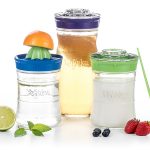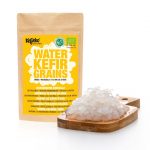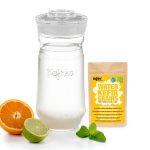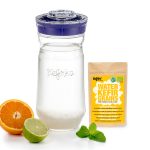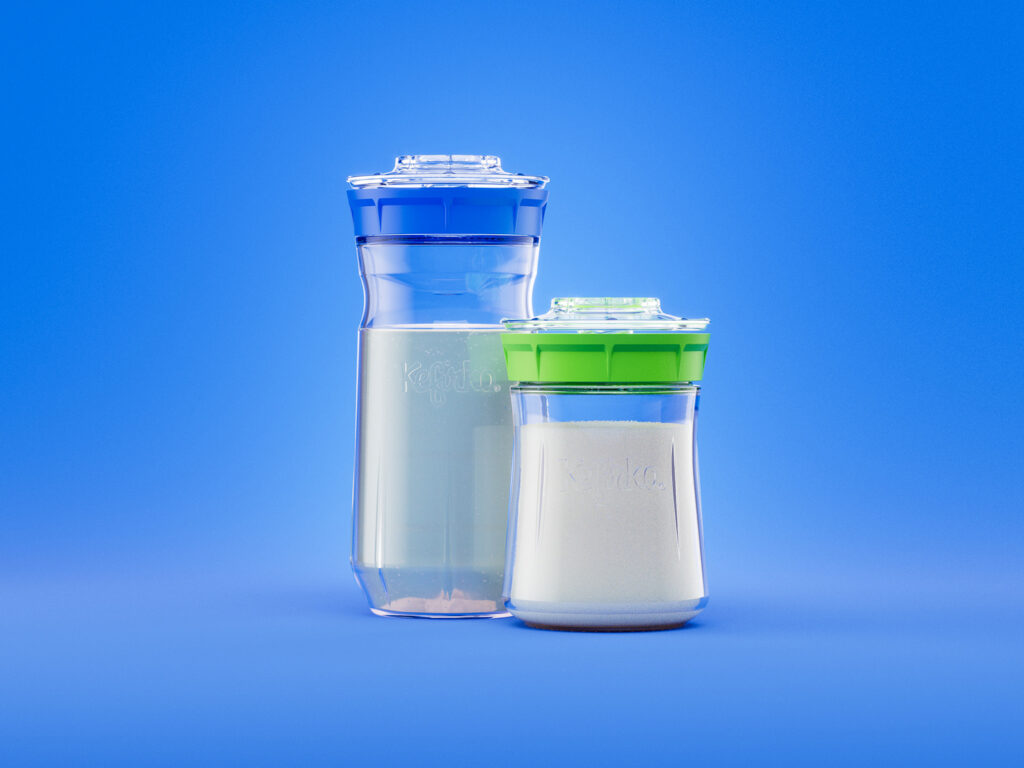FERMENTING WATER KEFIR
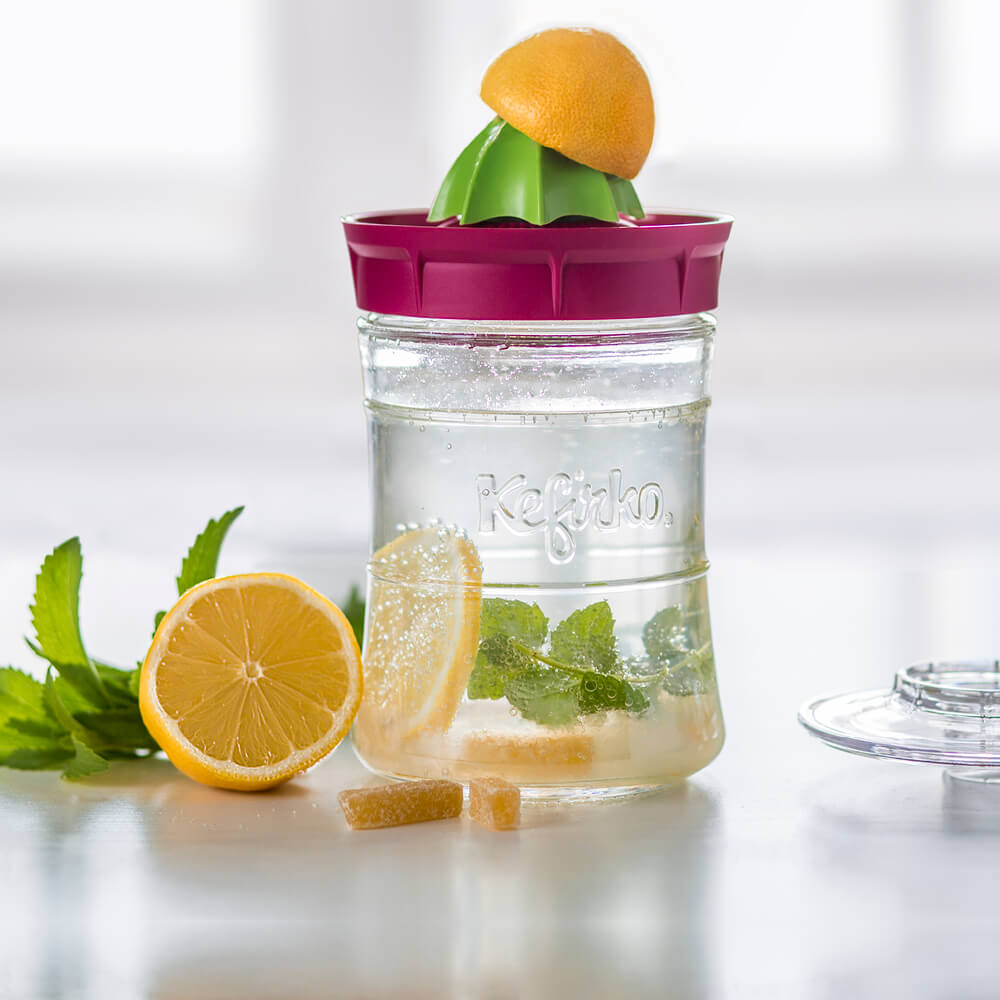
Water kefir is a fermented beverage, filled with probiotics and other healthy ingredients. Kefir is made by leaving special reusable living cultures, called kefir grains, in water and sugar solution to ferment for about 48 hours. Kefir helps boost your immune system, improves your digestion, helps regulate your cholesterol, and has other numerous beneficial effects.
See answers to FAQs about water kefir below.
Fermentation is a process that happens when you leave kefir grains in water or milk. Fermentation is a metabolic process where live cultures consume sugar and produce organic acids, gases and alcohol. Traditionally we use fermentation to produce wine and beer, to preserve food (pickled vegetable, kimchi) and for lacto-fermentation (kefir, yogurt).
Live cultures are essential
We need live cultures for fermentation – kefir grains are combination of yeasts and bacterias. Lactobacilli, for example, is the bacteria that converts lactose in milk (milk sugars) into lactic acid in yogurt and kefir giving it its sour taste.
STEP 1
Put the water kefir grains into the jar and fill it with fresh, non-chlorinated and non-filtered water. Add sugar and dried fruits (optional).
STEP 2
Open slightly the top lid of the jar in order to allow the air flow needed for the fermentation. Leave it at room temperature for about 1-2 days.
STEP 3
When the process of primary fermentation is finished (after approximately 1-2 days). Remove the top lid and strain the kefir into glass jar/bottle. The grains will remain in the Kefirko jar.
STEP 4
After the kefir is strained you can add some fruit juice or squeeze fresh citrus juice into the water kefir. You can seal the bottles and leave it in the fridge for another day for second fermentation.
Kefir is a traditional fermented beverage with numerous health benefits: but to get the best of it, it has to be fresh – and for this home preparation is the best.
Start making kefir at home
Making kefir by yourself gives you the opportunity to enjoy all the richness and health benefits of the beverage. Since no preservatives are added, you have better control over the quality of your kefir. You can also tailor it to your own taste. You can make as much or as little of kefir as you need. Compared to the kefir you can buy in stores, the homemade beverage contains a much higher degree of kefir-specific active substances which are important for your health. By culturing and storing homemade milk kefir in a glass jar you will avoid unwanted exposure to BPA and other toxins from plastic. You will save money and create less waste.
- Dissolve 30g sugar in 300ml water and add kefir grains + a pinch of baking soda.
- Leave to ferment for 2 days.
- Strain and discard water.
- Repeat step 1-3 a few times, until you notice activity.
- Strain and use the grains for water kefir.
It’s important to use non-chlorinated water when you are making kefir. The chlorine in the water can kill the live microorganisms in the kefir grains.
You can use filtered water but be careful with that. Filtered water is usually very low in minerals which are important for the growth of grains, especially when you are trying to revive them. It’s very important to add minerals to the water in this case (sugar, baking soda, molasses, etc.).
Use lukewarm water when you are activating water kefir grains and later on when you are making kefir regularly. All big temperature changes may negatively affect the kefir grains.
When you are trying to activate kefir grains, it’s important to boost their growth. For this reason add some unrefined brown sugar during this initial steps. You can use 25g white and 5g brown sugar during the activation.
It’s important to use at least a part of sugar that is rich in minerals in the process of activating the grains. Later on you may need to reduce the amount of minerals by using white sugar, especially if your grains are becoming mushy. That shows over mineralisation.
Kefir grains need minerals to thrive. Sometimes there is enough minerals in the water you use, other times it’s necessary to add them.
When you may need to add minerals:
- during activation of the kefir grains,
- when grains are not growing,
- when kefir does not ferment in over 48 hrs.
What minerals can I add?
- Baking soda – less than a teaspoon.
- Molasses – less than a teaspoon.
- Unrefined sugar – to replace part of white sugar.
- Mineral drops – few drops per liter.
Make water kefir with organic water kefir grains:
When water kefir grains get too much minerals they usually become mushy and are starting to degrade. If you notice this happening to your grains, act quickly, otherwise you may lose your grains.
Your grains do not need added minerals every batch you make. Especially when the water that you use is already rich in minerals. Using unrefined sugar and adding molasses, baking soda or mineral drops every batch may be just too much.
First, you need to figure out why kefir does not have bubbles then you will see if anything can be done to increase the amount of bubbles in your beverage.
Why there aren’t bubbles in my kefir?
- Maybe your grains aren’t active yet. Sometimes, especially if we just started preparing kefir, grains need some time to reach full activity. This is done by regular feeding of the grains with right ratios sugar : water.
- Too much water for the amount of water kefir grains. It’s best to use approximately 30 g of kefir grains for 300 ml of water and sugar solution.
- Low environmental temperature, too short fermenting time. These are both reasons that you kefir does not produce enough bubbles. During winter time, it can take up to 4 days to ferment water kefir.
How can I increase bubble formation in my water kefir?
If you considered all the reasons your kefir isn’t fizzy, there are some other things you can do:
- Feed your grains regularly. Proper routine makes grains more active. This also means they produce more bubbles.
- Close the lid. This will prevent airflow, which means gas will not be able to come out during fermentation. Be careful for bottle explosion if you ferment longer than 48 hrs.
- Longer fermentation. If you like more sour, less sweet taste of kefir, you can leave it to ferment longer time. This will also increase bubble formation.
- Second fermentation. This is the part of the process where you can even increase the bubble formation. Usually by adding fresh juices and/or fruit to the strained kefir. Keep the lid closed during second fermentation.
The word kefir is believed to have originated from the Turkish word “keif” which means “good feeling”. It’s pronounced many different ways, most common are “key-fur”, “keh-fear”, “k’fear”, “kuh-fear”, “kee-fer”.
To prepare kefir at home you need a glass or plastic jar, sieve and lid or cloth to cover it. Kefirko is all-in-one tool made of glass jar (0,6 l or 1,4 l), plastic strainer and top lid that enables slightly open jar during fermentation.
Use proper supplies for fermenting
Always use a glass jar with a lid to prepare kefir. Live cultures are very sensitive to the different substances that can transfer from materials and affect the quality of kefir or even damage the cultures. It is not recommended to use any metal or plastic in long contact with the kefir because it can expose it to BPA and other toxins from plastic. All plastic material used in Kefirko Kefir Maker are certified BPA free and food safe materials.
There are many positive benefits for the health and general well-being when drinking kefir.
Here are listed benefits of kefir
- contains easily digested proteins
- full of good bacteria helping digestion
- contains antimicrobial strains of lactobacilli
- boosts immunity
- supports detoxification
- helps balance gut bacteria disturbed by antibiotics can heal the skin after severe burns
- heals the inflammatory bowel disease
- helps fight allergies
- can be consumed by the lactose intolerant
- lowers the blood pressure
- helps in building bone density
- kills candida
- can help combat anemia
- used in preventing and treating cancer
Start fermenting with Kefirko
Start your dose of kefir gradually by drinking about 100 ml of kefir a day. You will start noticing the effects of kefir quickly. It depends on how sensitive you are and what is your nutrition like until starting with kefir. Reactions can be huge and it’s possible for them to became more intense until your body adapts.
Side effects of drinking kefir:
- stomach cramps/gurgles,
- constipation,
- bloating …
If you have no experience with consuming live food the effects will probably be more obvious. You should not stop drinking kefir if the effects aren’t too overbearing. If you don’t manage to overcome them, stop drinking kefir and get medical advice. It is possible that kefir is not for you.
Increase the amount of kefir
When you manage to overcome these effects and your body adapts to daily drinking kefir. You can slowly build up to the desired amount of kefir. It’s recommended to drink about 200-300 ml of fresh milk kefir a day (1 cup) and you can add a bit more if you drink water kefir (350 ml/1,5 cup). Kefirko glass jar has tactile markings on the side that indicate 300 ml – 1 dose of kefir.
You will start experience the benefits of drinking kefir soon. It’s best to drink kefir non-stop for at least 3 month to feel the desired effects on your well-being.
It’s possible you have to limit your kefir intake if you experience serious side effects. This happens when you have some health conditions that recommend consuming less proteins, probiotics, acidic food etc. You should always seek advice from your doctor when you feel discomfort. You should find your own limit where you feel good and stick to it. Whether is less or more than 1 cup it depends on you.
Start slowly
Once you get used to drinking kefir you will not feel the uncomfortable symptoms anymore. This should happen in approximately 2 weeks when you will be starting to feel positive benefits of kefir. But note, for best result you should drink kefir every day!
Surrounding room temperature is very important factor of fermentation process. For best results, prepare kefir at room temperature (20-24 degrees C). If you have slightly more warm temperatures or in summer months you might notice it takes less time for kefir to ferment. The opposite is also true. When in colder temperatures, the fermentation slows down and it can take longer for kefir to ferment.
Get your kefir making supplies here:
Water kefir usually ferments 48 hours. Taste the kefir during fermentation. If you prefer more sweet taste, stop the fermentation earlier. Otherwise you can ferment it even longer than two days. Note, after the sugar is consumed by live microorganisms, the level of alcohol in the beverage can increase.
Second fermentation means fermenting without the cultures. Second fermentation gives your ferment a full spectre of live microorganisms. Many claim that only with second fermentation you can really benefit from fermented beverage.
This is also the time when you can add some flavoring and make your kefir more fizzy. Even though it is important, it’s not obligatory. You will still benefit a lot from freshly made kefir.
The activation period follows long or short time storage of kefir grains. Grains aren’t active because of vacation, taking a break from kefir, shipping and other reasons. Meanwhile kefir grains are stored in a cool place in water with sugar. While they are being shipped they are also exposed to low ambient temperatures during winter time. They slow down their activity.
When we want to use them again there is an activation period before the grains become fully active as before.
The duration of this process depends on how long they were stored and the conditions of this storage. Usually activation time takes 7-14 days. In some cases it can take more, even a month for grains to regain full activity.
There are some signs that the kefir grains are active enough so you can use them to prepare kefir:
- Smell and taste. Distinctive smell and taste of kefir is a bit sour, there can still be some sweetness to it.
- Bubbles. You will see bubbles flowing in the kefir, once the kefir starts fermenting. This does not mean it will actually be fizzy when you taste it, but it’s a sign of fermentation.
